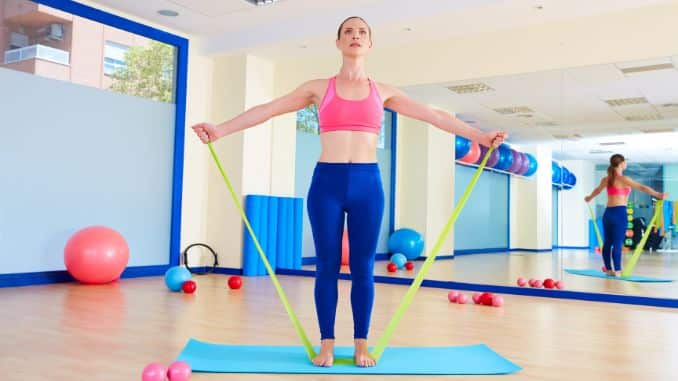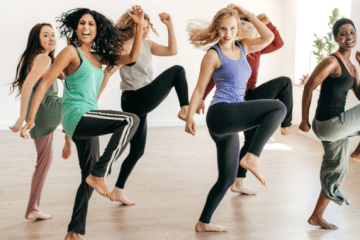Standing band exercises offer a versatile and effective way to enhance fitness routines for individuals at any level. This article explores various standing band exercises and their benefits, including building strength, improving flexibility, and increasing stability.
Using resistance bands allows for targeted muscle engagement and core activation, enhancing overall physical performance safely and efficiently. The portability of resistance bands also facilitates easy integration into workouts at home, the gym, or on the go.
If you're looking to elevate your fitness, standing band exercises provide a dynamic option to achieve your goals.
Introduction to Standing Band Exercises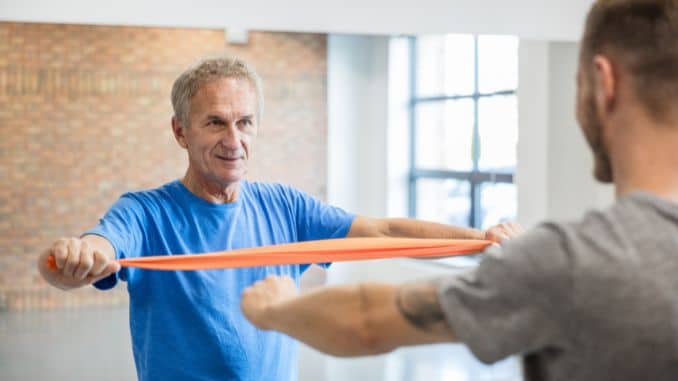
Standing band exercises use elastic bands to provide resistance, allowing for a full range of motion and engaging multiple muscle groups simultaneously.
Unlike traditional weightlifting that relies on gravity and external weights, these exercises generate resistance through band tension.
A key advantage is their adaptability; resistance bands can be adjusted to suit various fitness levels and goals, making standing band exercises accessible and effective for everyone from beginners to experienced athletes.
Benefits of Incorporating Standing Band Exercises into Your Fitness Routine
There are numerous benefits to incorporating standing band exercises into your fitness routine. Here are some of the key advantages that make these exercises a valuable addition to any workout regimen:
- Improved Strength: Standing band exercises use resistance bands to target specific muscle groups, helping to build strength and increase muscle tone. [¹]
- Enhanced Flexibility: Using resistance bands for stretching provides a controlled stretch that can improve flexibility, increase range of motion, and enhance athletic performance while preventing injuries.
- Increased Stability and Balance: The resistance from the bands in standing band exercises demands stability and balance, improving these attributes and reducing the risk of falls and injuries.
- Engagement of Multiple Muscle Groups: Standing band exercises work for multiple muscle groups at once, enhancing muscle coordination and functional strength compared to isolated exercises.
- Portability and Convenience: Resistance bands are lightweight and compact, offering a portable and convenient workout solution that can be used anywhere, from home to the gym or while traveling.
With these benefits in mind, let's explore how standing band exercises can work different muscle groups and the essential equipment you'll need to get started.
How Standing Band Exercises Work for Different Muscle Groups
Standing band exercises can effectively target various muscle groups [²] in your body, providing a comprehensive full-body workout. Here's a breakdown of how different exercises can work different muscle groups:
- Legs and Glutes: Squats, lunges, and leg press with resistance band workouts engage your quadriceps, hamstrings, and glutes, helping to build strength and tone in your lower body.
- Core: Standing band exercises can engage your core muscles in a unique way, forcing them to stabilize your body as you perform different movements. Exercises like standing wood chops and standing core twists can help strengthen your abs, obliques, and lower back muscles.
- Arms and Shoulders: Resistance bands can be used to perform various arm and shoulder exercises such as bicep curls, triceps extensions, and shoulder presses. These exercises target your biceps, triceps, and deltoid muscles, helping to build upper body strength and definition.
- Back: Standing band exercises can effectively target your back muscles, helping to improve posture and strengthen your upper and lower back. Exercises like standing rows and lat pulldowns engage your rhomboids, trapezius, and latissimus dorsi muscles.
- Chest: Resistance bands can be used to perform chest presses and fly exercises, targeting your pectoral muscles. These exercises help to strengthen and tone your chest muscles.
By incorporating a variety of standing band exercises into your routine, you can effectively target and strengthen different muscle groups, creating a well-rounded and balanced physique.
Essential Equipment for Standing Band Exercises
To get started with standing band exercises, you'll need a few essential pieces of equipment. Here's what you'll need:
- Resistance bands: The key component of standing band exercises is the resistance bands themselves.
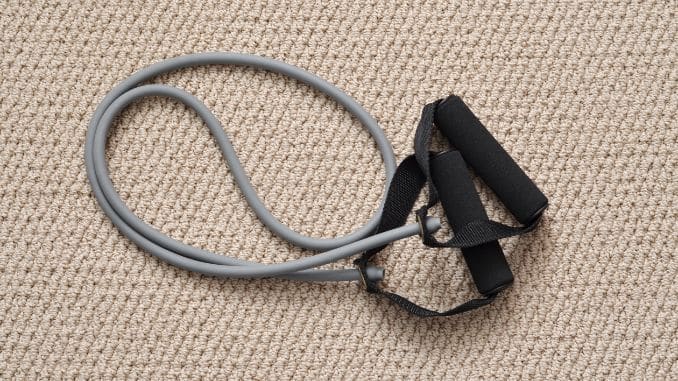
- Anchoring system: Depending on the exercise, you may need an anchoring system to secure the resistance bands in place.
- Handles and accessories: Some resistance bands come with handles or attachments that can be used to vary the exercises and target specific muscle groups.
Once you have the necessary equipment, it's time to learn the proper form and technique for standing band exercises.
Beginner Standing Resistance Band Exercises
Warm-Ups:
1. Shoulder Roll
Begin in an upright standing position with your feet flat and shoulder-width apart, maintaining good alignment with your head, shoulders, hips, and legs. Engage your core. Lift your shoulders, then roll them down and back until you feel resistance in your shoulder blades. Lower your shoulders to the starting position, relax, and repeat the movement in the opposite direction. Complete 10 repetitions.
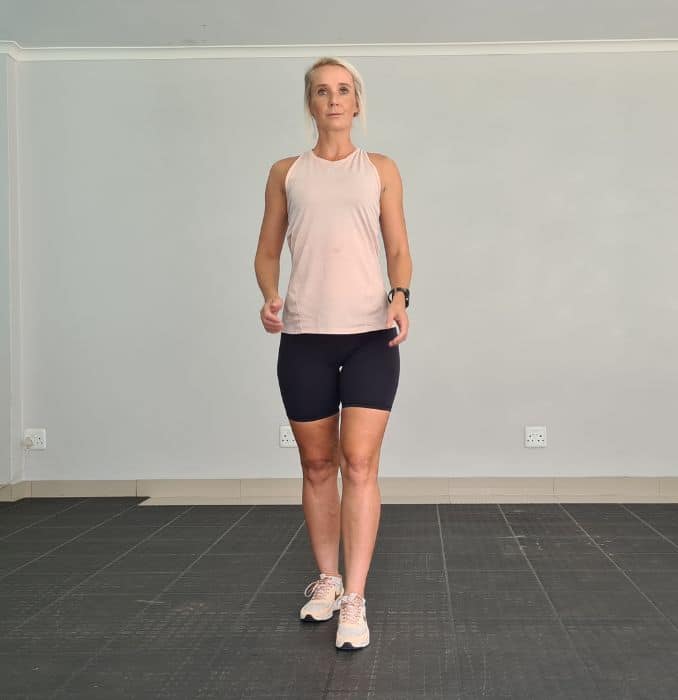 |
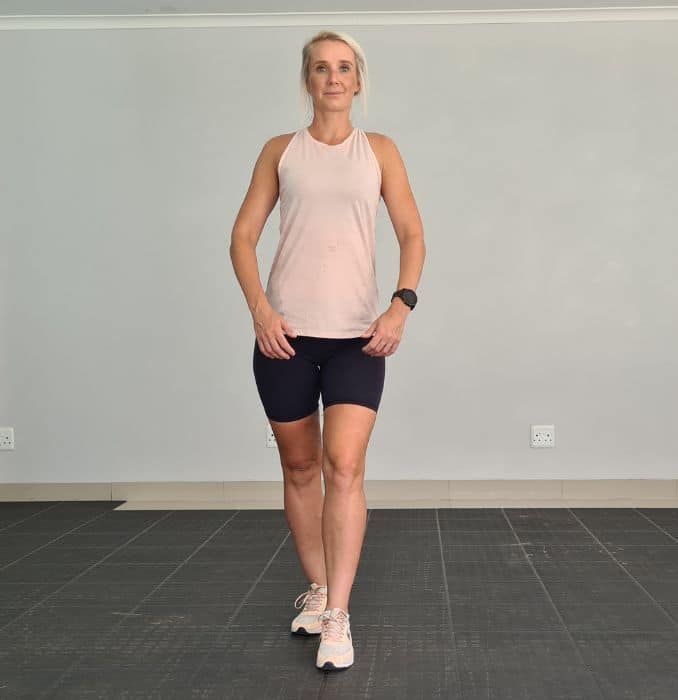 |
2. Standing Twist
Begin in an upright standing position with your feet slightly wider than shoulder-width apart, maintaining good alignment with your head, shoulders, and hips. Arms extended in front of your body with your palms pressed together at chest height. Engage your core and twist your upper body as you open one arm to the side, keeping your hips locked in the forward position. Return to the starting position and repeat the movement on the opposite side. Complete 10 repetitions.
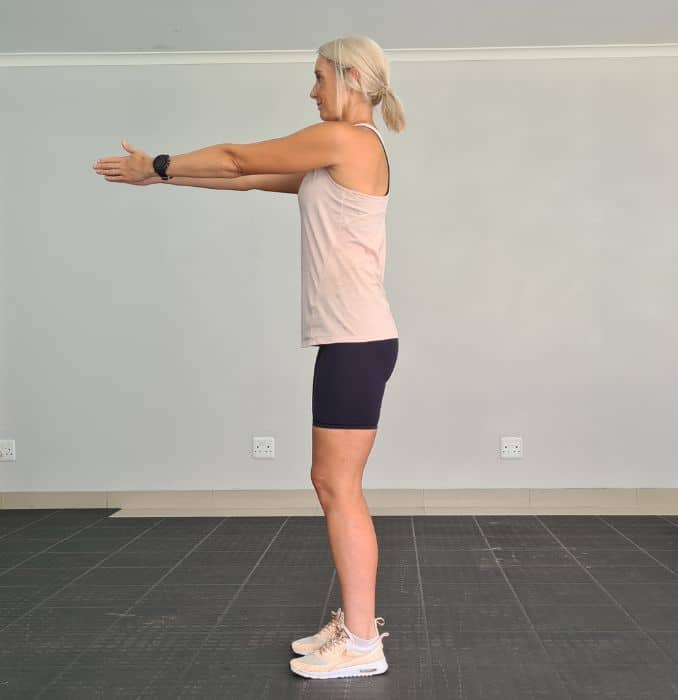 |
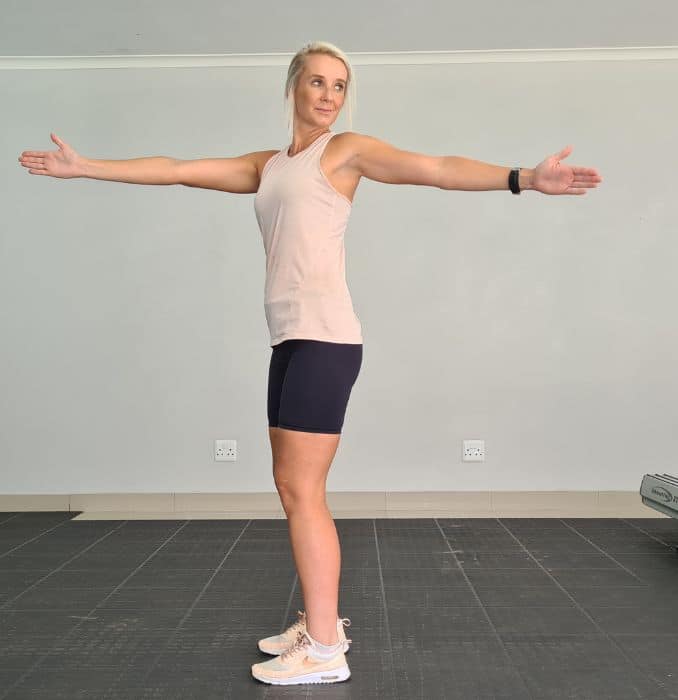 |
3. Side Reach
Begin in an upright standing position, feet shoulder-width apart, maintaining good alignment with your head, shoulders, hips, and legs. Engage your core. Inhale and reach across your body at chest height with one arm. Twist your upper body to stretch as far as you are able. Return to the starting position and repeat the movement on the opposite side. Complete 10 repetitions.
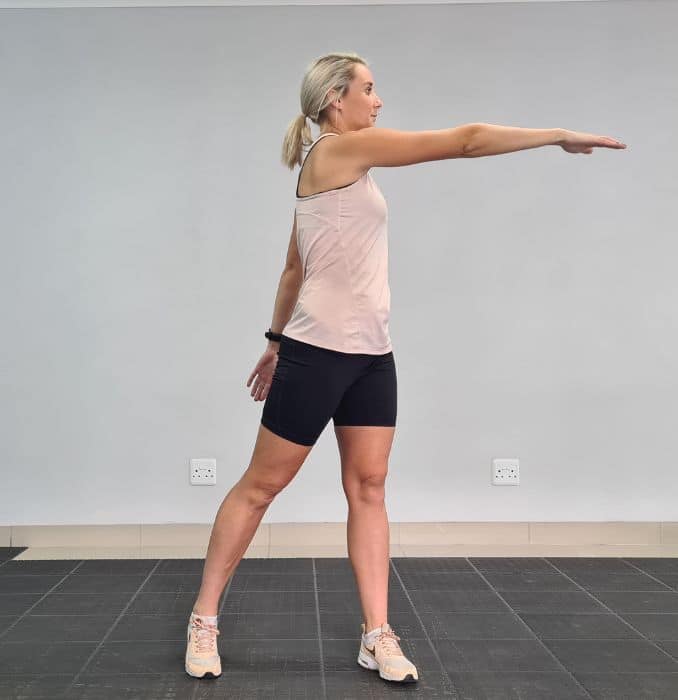 |
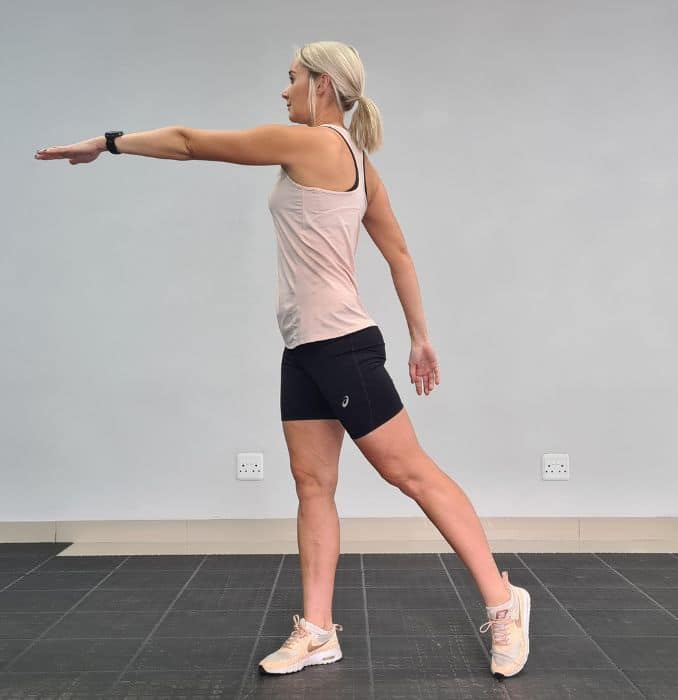 |
4. Squat
Begin in an upright standing position with your feet hip-width apart, maintaining good alignment with your head, shoulders, hips, and legs. Bring your hands in front of your body at chest height. Engage your core, knees bent, and hinge through your hips to move into a squat position. Raise back to an upright standing position, squeezing your glutes at the top. Repeat the movement and complete ten repetitions.
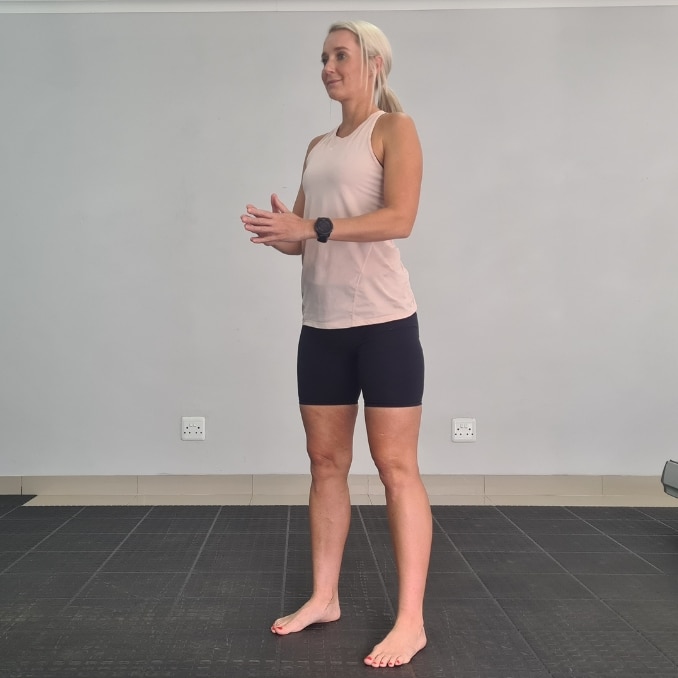 |
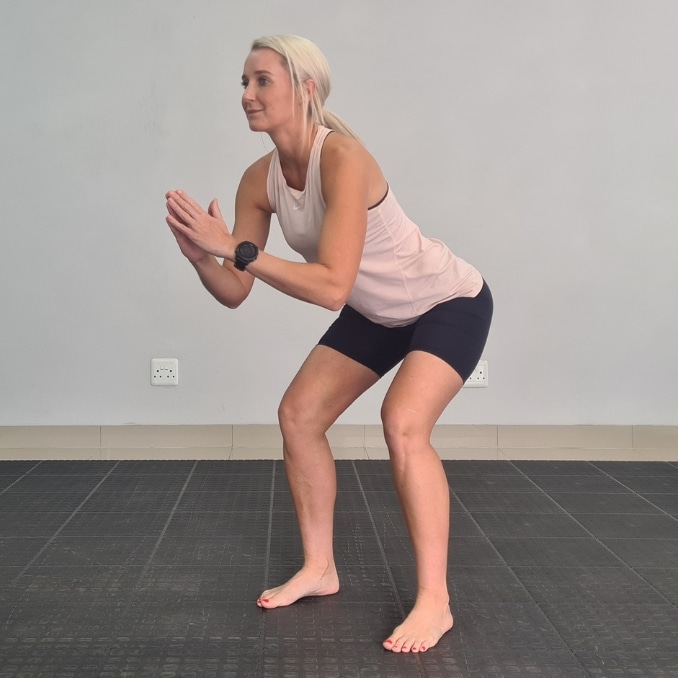 |
Routines:
1. Shoulder Sweep
For this exercise, kindly use resistance tubing.
Begin in an upright standing position with your feet shoulder-width apart, maintaining good alignment with your head, shoulder, and hips. Step your left leg on the center of the resistant tubing. Keep your left leg straight and hold the handles in each hand with your palms facing upward. Then, engage your core and sweep your arms to bring the tubing handles to shoulder height. Return to the starting position and repeat the movement. After several repetitions, switch to the opposite leg. Complete 3 sets of 10 repetitions on each side.
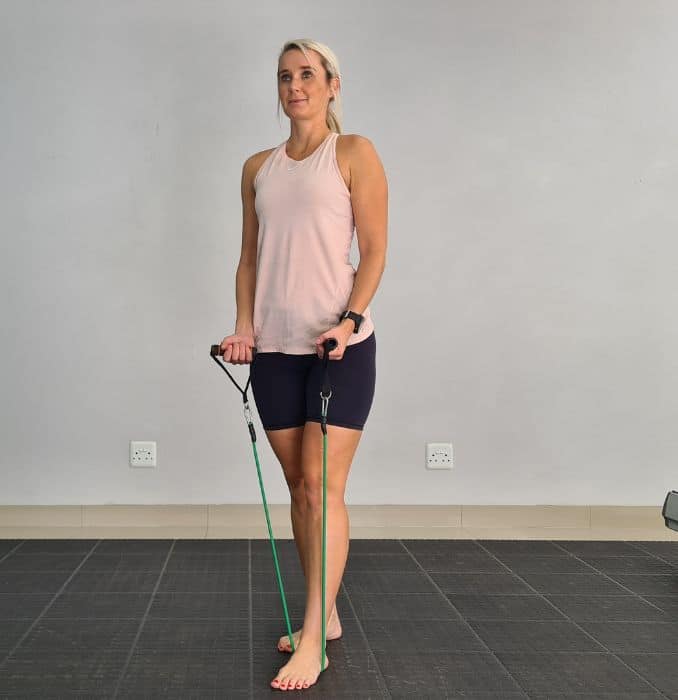 |
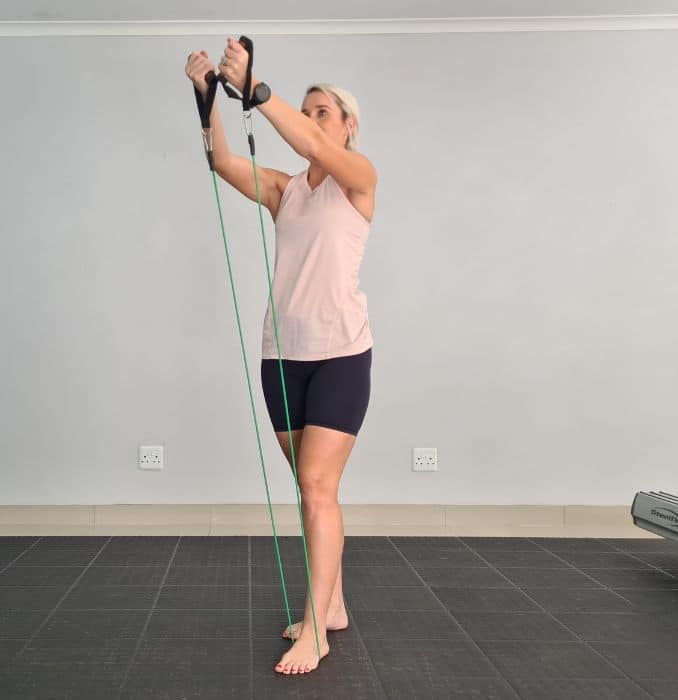 |
2. Upright Rows
Begin in an upright standing position with your feet hip-width apart, maintaining good alignment with your head, shoulders, hips, and legs. Step on the center of the band with both feet and hold the ends of the tubing in each hand with your palms facing inward. Hinge through your hips to bend your upper body forward as you slowly lower your hands to the floor. Engage your core and pull the handles up to chest height, bending your elbows out at your sides, ideally parallel to the floor. Lower your arms to the starting position and repeat the movement. Start with 1 set of 10 repetitions.
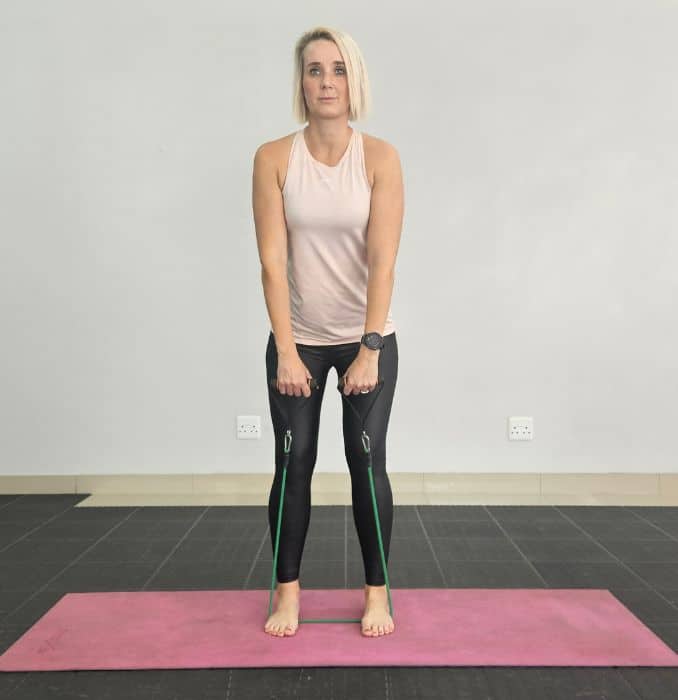 |
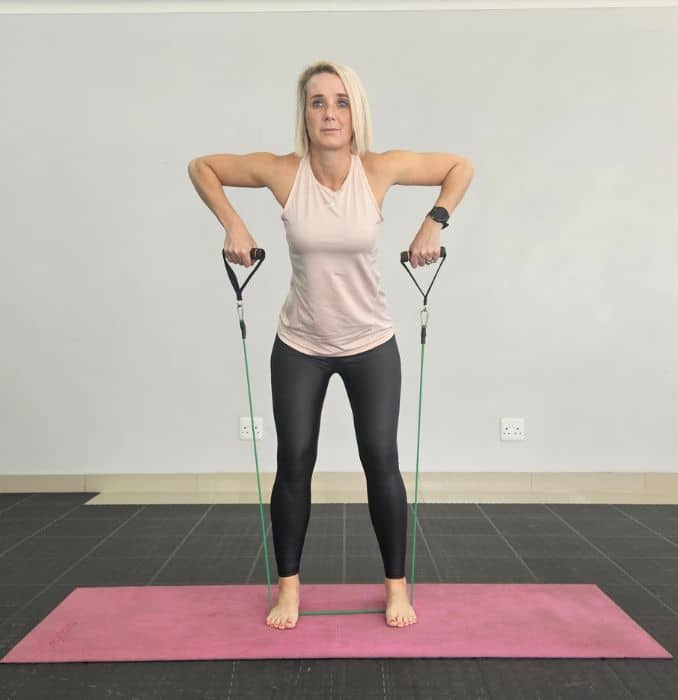 |
3. Bicep Curl
Begin in an upright standing position with your feet shoulder-width apart, maintaining good alignment with your head, shoulder, hips, and legs. Step your right foot forward on the center of the resistant tubing. Hold the tubing handles in each hand with your palms facing upward, pressing your elbows against the side of your body. Engage your core and curl both arms to bring the tubing handles to chest height. Return to the starting position and repeat the movement. Complete 3 sets of 10 repetitions on each side.
Furthermore, to intensify the movement, you can alternately curl your arms to bring the tubing handle to chest height.
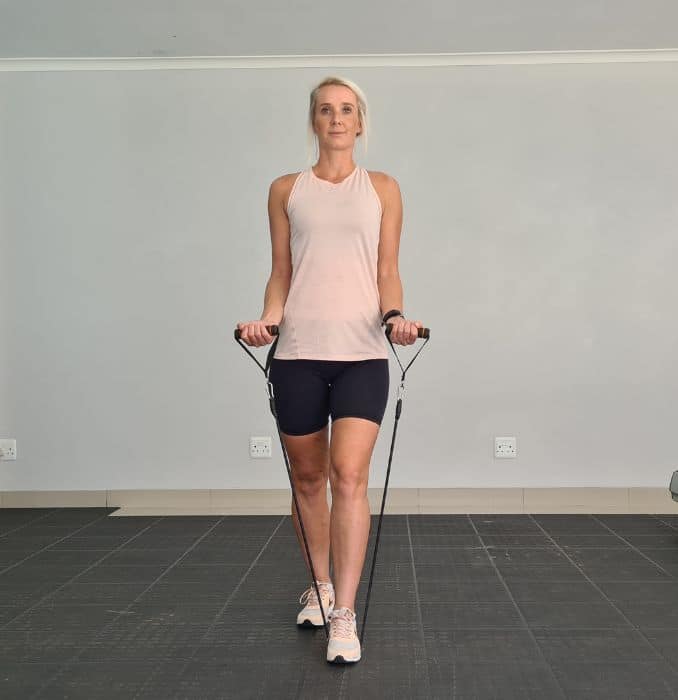 |
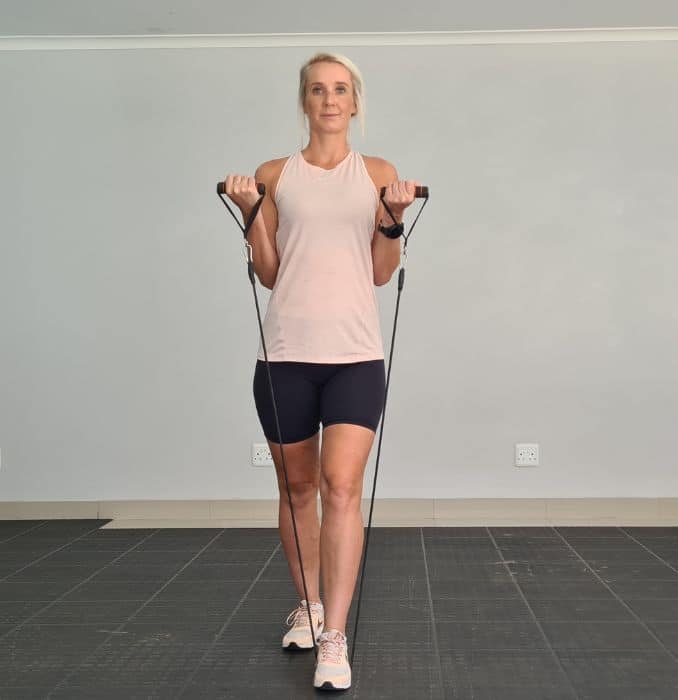 |
4. Shoulder External Rotation
Begin in an upright standing position with your feet shoulder-width apart, maintaining good alignment with your head, shoulder, hips, and legs. Engage your core and hold the resistant tubing handle with each hand, grabbing most of the tubing on the other hand and anchoring it at the center of your stomach. Maintain your legs and arms straight and steady, and then slowly open the tubing and return it to the other side. Return to the starting position and repeat the movements on the opposite side. Complete 10 repetitions.
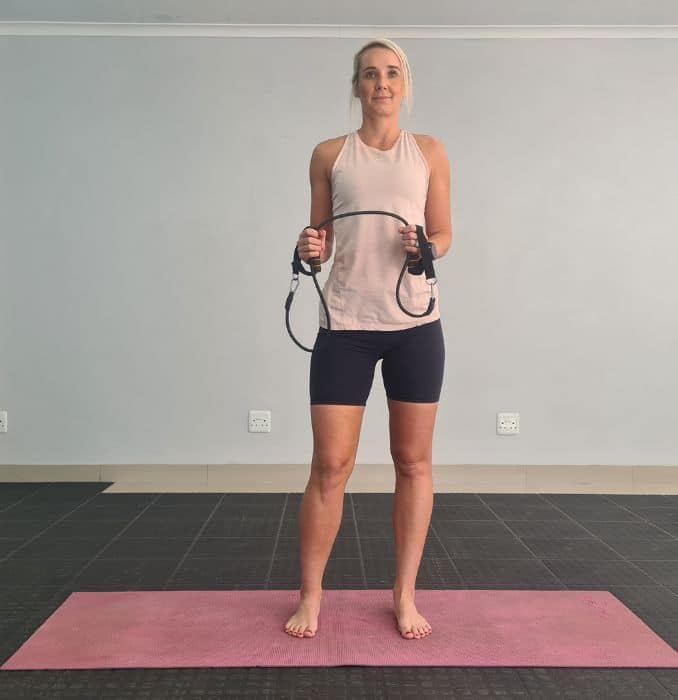 |
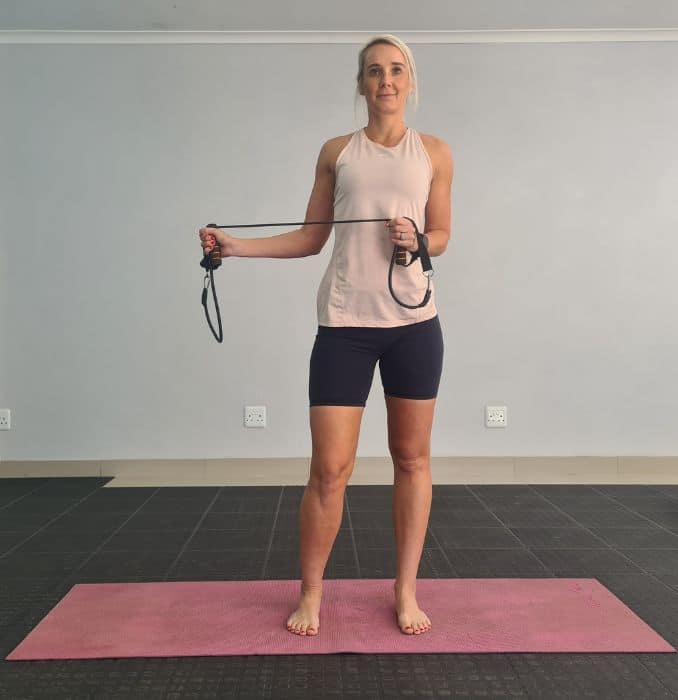 |
5. Bend Over Rows
Begin in an upright standing position with your feet hip-width apart, maintaining good alignment with your head, shoulders, hips, and legs. Step your left foot on the center of the resistance tubing. Bend your left knee and hold the ends of the tubing in each hand. Hinge through your hips forward, making your right leg straight. Engage your core and pull both arms up in a rowing motion, keeping your elbows 30 to 45 degrees away from your body. Return to the starting position and repeat the movement on the opposite foot. Start with 3 sets of 15 repetitions on each side.
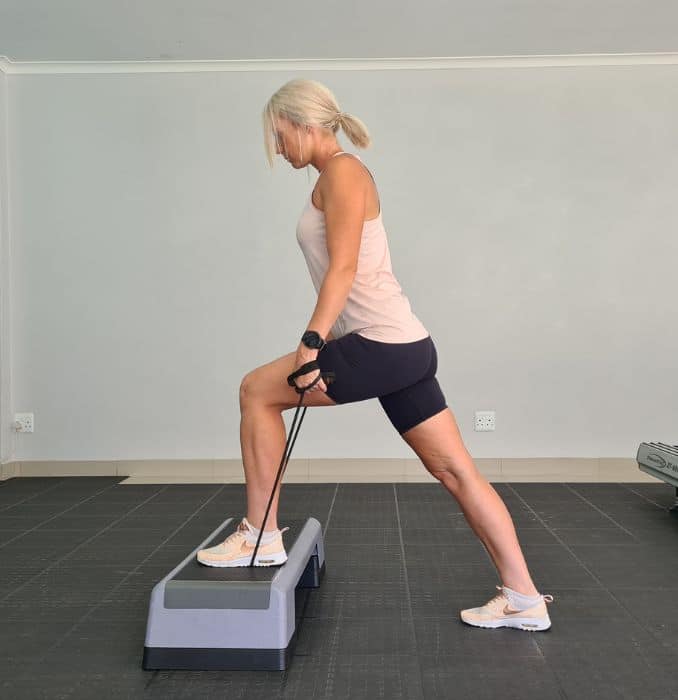 |
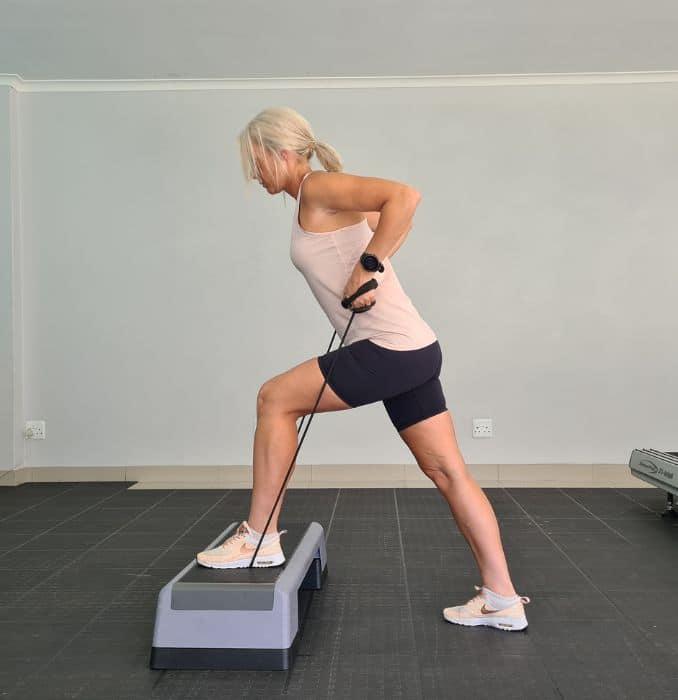 |
6. Triceps Kickback
Begin in an upright standing position on the center of the resistance tubing with your feet hip-width apart, holding a handle in each hand with your palms facing your body. Slightly bend your knees and hinge through your hips. Bend your arms, keeping your elbows 30 to 45 degrees away from your body. Engage your core and extend your one arm back to slightly past your hips. Return to the starting position and then repeat the movement. After several repetitions, repeat the movement on the opposite side. Complete 10 repetitions.
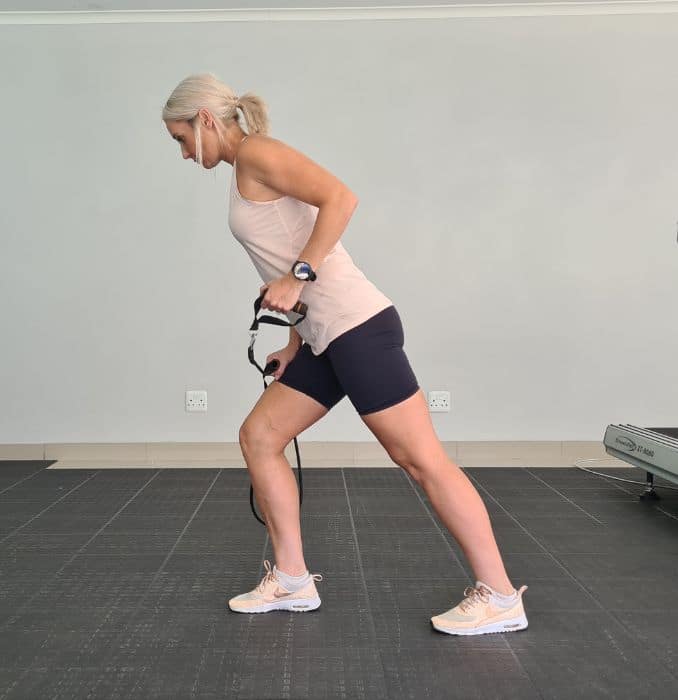 |
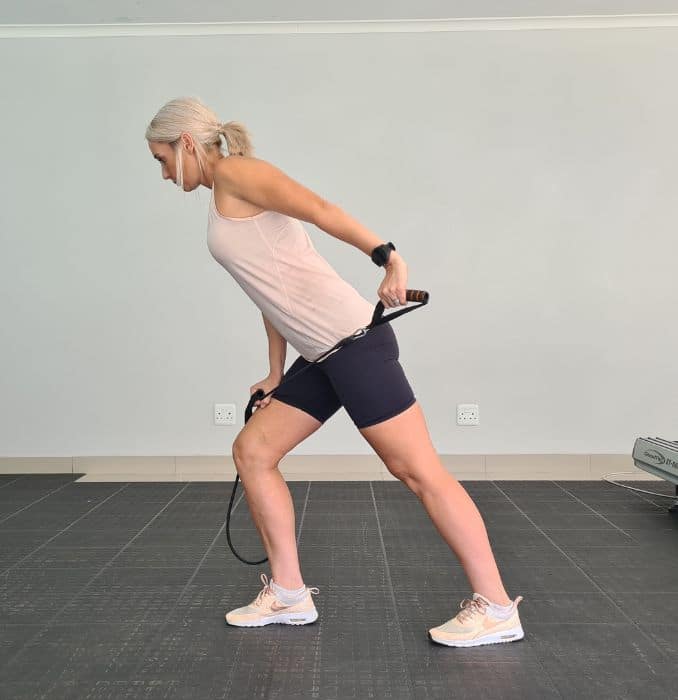 |
Cool Downs:
1. Cross Arm Stretched
Begin in an upright standing position with your feet shoulder-width apart, maintaining good alignment with your head, shoulder, hips, and legs. Engage your core and bring your left hand across your body, then intensify the stretch by pulling your arm closer to your opposite shoulder. Hold this position for 20 seconds. Relax and return to the starting position. Repeat the movement on the opposite side.
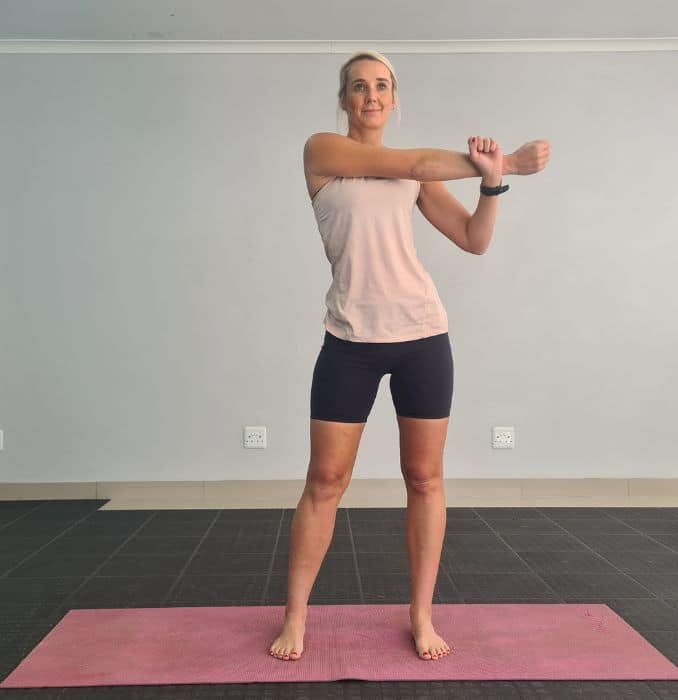
2. Back Stretch
Begin in an upright standing position with your feet shoulder-width apart, maintaining good alignment with your head, shoulders, hips, and legs. Place on the backs of your hips. Engage your core and look upward as you arch your back slightly for a light stretch. Hold this position for several deep belly breaths through your nose and mouth. Relax and repeat the movement.
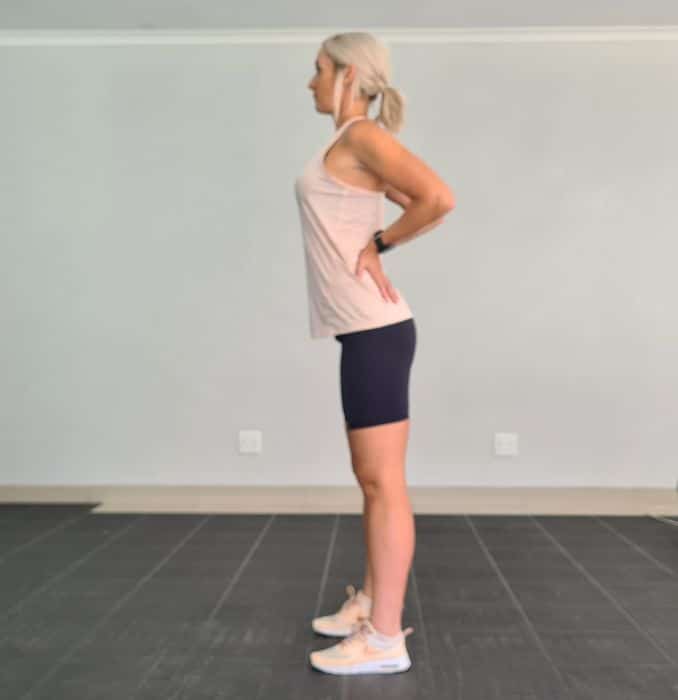
Variation 1
Begin in an upright standing position with your feet shoulder-width apart, maintaining good alignment with your head, shoulders, hips, and legs. Make your knees slightly bent and place your hands on them. Engage your core slowly, round out your midback, and lower your head. Hold this position for several deep belly breaths through your nose and mouth. Relax and repeat the movement.
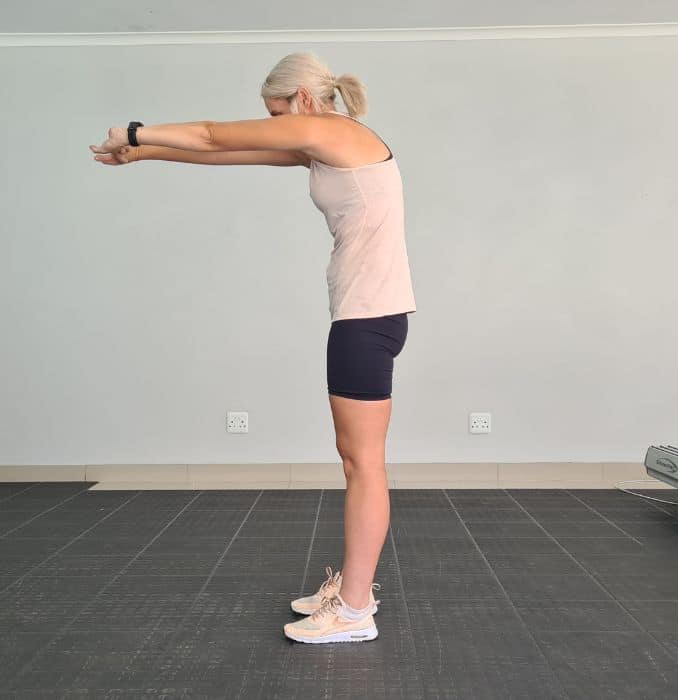
Proper Form and Technique for Standing Band Exercises
Proper form and technique are crucial when performing standing band exercises to maximize their effectiveness and prevent injuries. Here are some key tips to keep in mind:
- Warm-up: Initiate every exercise session with light cardio and dynamic stretching to boost blood circulation and ready your muscles.
- Start with lighter resistance: Beginners should use lighter resistance bands, progressively increasing intensity as strength improves to minimize injury risk.
- Maintain proper posture: Keep your spine neutral, shoulders relaxed, and core engaged during exercises to prevent strain on joints and muscles.
- Controlled movements: To enhance effectiveness and reduce injury risk, execute exercises with precise, controlled movements, avoiding momentum.
- Breathe: Ensure consistent breathing—inhale during muscle lengthening and exhale during muscle shortening—to properly oxygenate muscles and maintain good breathing patterns.
By following these tips, you can get the most out of your standing band exercises while minimizing the risk of injury.
Conclusion: Take Your Fitness to the Next Level with Standing Band Exercises
Standing band exercises offer numerous benefits to enhance your fitness routine, including building strength, improving flexibility, enhancing stability, and engaging multiple muscle groups. These exercises allow for targeted muscle workouts and dynamic challenges that help you meet your fitness goals. Thanks to resistance bands' portability, you can easily incorporate these exercises into your routine at home, the gym, or while traveling. Starting with basic exercises and progressing to more advanced ones as you improve, standing band exercises can significantly boost your fitness and help you master new techniques.
Ready to take your workouts to the next level? Check out our 10-Piece Resistance Tubing Kit and start incorporating versatile and effective resistance band exercises into your fitness routine today!

